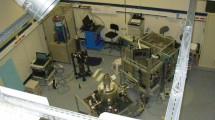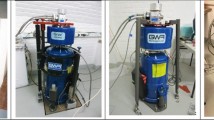Abstract
The instrumental drift of the superconducting gravimeter in Membach, Belgium, is estimated using 9 years of co-located and episodic absolute gravity measurements. We show that the best model of the long-term drift of the SG-C021 is an exponential. The thermal levelers used to compensate tilts are unlikely to induce the observed drift. Rather, the capacitance bridge, magnetic variations, gas adsorption on the levitating sphere, or helium gas pressure variations around it are most likely the possible combined causes of the observed instrumental drift. In practice, either linear or exponential drift models are equivalent as long as the record duration does not exceed 10 years. For longer records, this study demonstrates that an exponential models the drift better than a simple linear trend.
Similar content being viewed by others
References
Amalvict M, Hinderer J, Mäkinen J, Rosat S, Rogister Y (2004) Long-term and seasonal gravity changes at the Strasbourg station and their relation to crustal deformation and hydrology. J Geodyn 38(3–5):343–353
Bower DR, Liard J, Crossley DJ, Bastien R (1991) Preliminary calibration and drift assessment of the superconducting gravimeter GWR12 through comparison with the absolute gravimeter JILA2. In: Poitevin C (ed) Cahiers du Centre Européen de Géodynamique et de Séismologie, vol 3. Luxembourg, pp 129–142
Crossley DC, Hinderer J, Boy J-P (2005) Time variation of the European gravity field from superconducting gravimeters. Geophys J Int 161:257–264
Francis O, Van Camp M, van Dam T, Warnant R, Hendrickx M (2004) Indication of the uplift of the Ardenne in long term gravity variations in Membach (Belgium). Geophys J Int 158(1):346–352
Goodkind JM (1999) The superconducting gravimeter. Rev Sci Instrum 70(11):4131–4152
Goodkind JM, Young C, Richter B (1991) Comparison of two superconducting gravimeters and an absolute gravimeter at Richmond, Florida. In: Poitevin C (ed) Cahiers du Centre Européen de Géodynamique et de Séismologie, vol 3. Luxembourg, pp 91–98
Hammer Ø, Harper DAT, Ryan PD (2001). PAST: paleontological statistics software package for education and data Palaeontologia Electronica 4(1):9. http://palaeo-electronica.org/2001_1/past/issue1_01.htm
Harnisch M, Harnisch G, Nowak I, Richter B, Wolf P (2000) The dual sphere superconducting gravimeter CD029 at Frankfurt a.M. and Wettzell. First results and calibration. In: Ducarme B, Barthélemy J (eds) Cahiers du Centre Européen de Géodynamique et de Séismologie, vol. 3. Luxembourg, pp 39–56
Kroner C, Jahr Th, Jentzsch G (2004) Results from 44 months of observations with a superconducting gravimeter at Moxa/Germany. J Geodyn 38(3–5):263–280
Prothero WA, Goodkind JM (1968) A superconducting gravimeter. Rev Sci Instrum 39:1257
Richter B, Zerbini S, Matonti F, Simon D (2004) Long-term crustal deformation monitored by gravity and space techniques at Medicina, Italy and Wettzell, Germany. J Geodyn 38(3–5):292–292
Van Camp M, Williams SDP, Francis O (2005) Uncertainty of absolute gravity measurements. J Geophys Res 110:B05406. DOI 10.1029/2004JB003497
Van Camp M, Vanclooster M, Crommen O, Petermans T, Verbeeck K, Meurers B, van Dam T, Dassargues A (2006) Hydrogeological investigations at the Membach station, Belgium and application to correct long periodic gravity variations. J Geophys Res 111. DOI 10.1029/2006JB004405
Virtanen H, Kääriäinen J (1997) The GWR T020 superconducting gravimeter 1994–1996 at the Metsähovi station, Finland. In: Reports of the Finnish Geodetic Institute, vol 97, p 4, Helsinki
Warburton RJ, Brinton EW (1995) Recent developments in GWR Instrument’s superconducting gravimeters, in Cahiers du Centre Européen de Géodynamique et de Séismologie, vol. 11, edited by C. Poitevin, Luxembourg, pp. 23–56
Williams SDP (2003) Offsets in global positioning system time series. J Geophys Res 108, B6, 2310. DOI 10.1029/2002JB 002156
Zerbini S, Richter B, Negusini M, Romagnoli C, Simon D, Domenichina F, Schwahn W (2001) Height and gravity variations by continuous GPS, gravity and environmental parameter observations in the southern Po Plain, near Bologna, Italy. Earth Planet Sci Lett 192:267–279
Author information
Authors and Affiliations
Corresponding author
Rights and permissions
About this article
Cite this article
Van Camp, M., Francis, O. Is the instrumental drift of superconducting gravimeters a linear or exponential function of time?. J Geod 81, 337–344 (2007). https://doi.org/10.1007/s00190-006-0110-4
Received:
Accepted:
Published:
Issue Date:
DOI: https://doi.org/10.1007/s00190-006-0110-4




